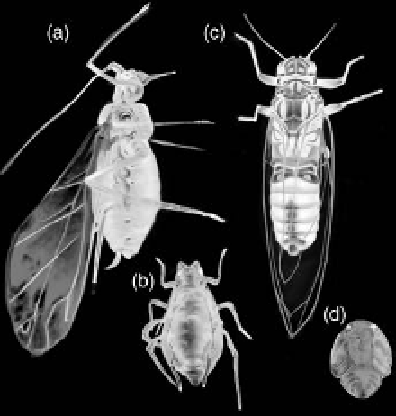Agriculture Reference
In-Depth Information
significant economic damage occurs. When in-
fested tubers are harvested, the development of
larvae and further damage to tubers can occur
in storage, depending on storage temperature.
Oftentimes, tubers near the surface of a pile in
storage are most drastically affected. Damage to
tubers can be reduced when the time between
vine kill and harvest is reduced, or when larvae
are controlled with pesticides prior to vine kill
and harvest. Harvest in warmer weather condi-
tions has more significant risk of tuber infest-
ation by potato tuber moth than harvest during
cooler weather. Additionally, regular hilling and
moist soil tend to reduce tuber damage by creat-
ing a physical barrier to infestation. Potato tuber
moths can be transported inadvertently in in-
fested seed, harvest bags, shipping containers,
or tare dirt.
9.2
Sucking Pests
Aphids (Aphididae)
Recognition
Aphids are small (
1-
3 mm), soft-bodied, phloem-
feeding insects characterized by a pair of unique
abdominal appendages called siphunculi, pheno-
typic plasticity involving specialized adult morphs
with and without wings, and parthenogenetic
viviparous reproduction (all summer forms are
female and give birth to live young without male
fertilization) during most of the annual life cycle
(Fig. 9.3a-b
)
. Winged forms almost always hold
the wings roof-like over the body. Aphids are
pests of crops worldwide, greenhouses, and
indoor ornamental plants.
Distribution and species
Sampling and monitoring
Blackman and Eastop (2000) list
15
species of
aphids known to feed on potatoes worldwide.
None of these is host specific to the crop, and
many have wide host ranges and large or cosmo-
politan distributions. Many other species that
do not feed on potatoes can be important to
crop production in their role as vectors of non-
persistent viruses (see Chapter
12
of this volume).
To minimize economic damage to the tubers, it is
essential to monitor the potato tuber moth popu-
lation, starting just prior to vine kill and con-
tinuing until the crop has been harvested. Adult
populations of potato tuber moth can be moni-
tored using pheromone traps, which attract
male moths with an aroma similar to that com-
ing from the female moth. This type of sampling
can provide a general idea of the relative popula-
tion, and therefore risk to the potato crop. Traps
are most effective when placed upwind of the
potato crop or storage. The threshold for the
number of moths caught per trap per day will
vary based on the potato crop stage. In the
north-west USA, the authors have observed that
commercially available pheromone lures cap-
ture several other unidentified gelechiid moths,
presumably species native to the shrub-steppe
habitat where potatoes are grown. The resulting
mix of species in pheromone traps substantially
complicates monitoring efforts in that region.
Larval numbers in foliage can be assessed by
looking for leaf mines on potato leaves. To assess
larval infestation of tubers, a random sample of
harvested tubers can be obtained and examined
visually. More precise detection may be possible
in the field prior to harvest by examining tubers
that are naturally protruding from the soil sur-
face. These surface-exposed tubers are most
likely to have larval infestation by potato tuber
moths.
Fig. 9.3.
Foliar pests. (a) Adult winged potato
aphid; (b) adult wingless green peach aphid;
(c) adult potato psyllid; (d) juvenile potato psyllid.
(Drawings by Dylan Vermeul, Richland, Washington,
USA.)

